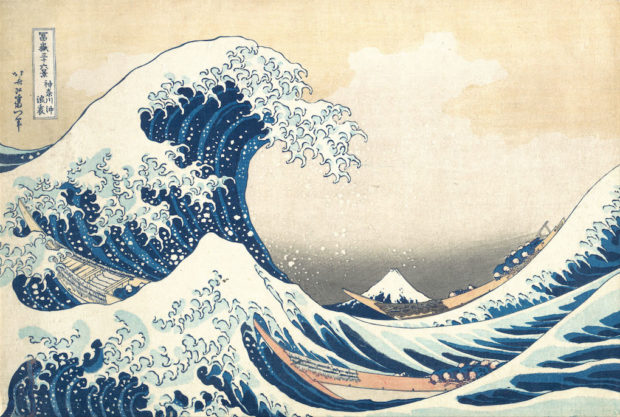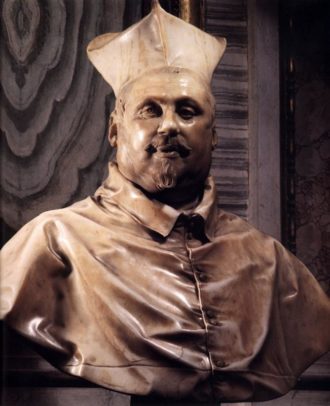This fall six temporary art exhibitions, each focused on a different artist, opened in Rome: “Arcimboldo” at the National Gallery of Ancient Art in Palazzo Barberini, “Bernini” at the Villa Borghese, “Hokusai: In the Footsteps of the Master” in the Ara Pacis, the Emperor Augustus’s altar to peace throughout his Empire, “Monet” in the Victor Emanuel Monument built to celebrate the unification of Italy, “Picasso. Between Cubism and Classicism: 1915-1925” in the Scuderie del Quirinale, and “Trombadori: The Essential Truth of Matters” at the Gallery of Modern Art on Via Francesco Crispi. “Hokusai” and “Picasso” close in mid-January; the others will remain on display until mid-February.

“Picasso. Between Cubism and Classicism: 1915-1925” could also be called “Picasso’s Italian Period”. It celebrates the centenary of Picasso’s first trip to Italy. Together with his friend Jean Cocteau, Picasso traveled to Italy in February 1917 to assist in the realization of Diaghilev’s “Parade” for the company Ballets Russes. In Rome he met and fell in love with one of the Ballets Russes’ ballerinas, Olga Khokhlova, who later became his first wife and the third of his seven “muse” loves.
Along with working on the production of “Parade” as a costume, prop, and set designer, during his stay in Rome Picasso realized another two artworks: “Harlequin and Woman with a Necklace” and “Italian Woman” (showing St. Peter’s dome in the background), both on display here along with some 100 paintings, sketches, postcards, and letters.
Although Picasso’s first trip to Italy was brief (two months), the ancient monuments of Rome, Naples, and Pompeii had an immense impact on his artistic style. Very interested in Baroque sculpture and painting, particularly in Bernini, the trip marks the end of his Cubist period and his return to the Figurative, such as his paintings “Seated Nude Drying her Feet” and “Three Women by a Fountain”, both on display.
His stage curtain for “Parade”, 52.5 X 33.8 feet so the largest work Picasso ever painted, was too big to fit in the Scuderie’s exhibition space so it’s on display in the Palazzo Barberini. Also located there is a splendid exhibition, the first ever in Rome and only the third during the last century, devoted to Milanese Arcimboldo (1526-1593), an esoteric and alchemical follower of Leonardo. The first, “Fantastic Art, Dada, and Surrealism”, was held in 1937 at MOMA in New York. In this context of Dadaism and Surrealism, he quickly became one of the most important forerunners of contemporary art movements.

Arcimboldo is best known for his imaginative composite portrait heads of each of the four seasons and each of the four elements, all eight displayed here side by side, and of “professions”, also composite heads of fruits, vegetables, fish and fowl. However, he started his artistic career working with his father in Milan’s cathedral before being called to the Hapsburg Imperial Court, first in Vienna and later in Prague. His 20 works here are shown in chronological order and reveal his talent as a multi-faceted protagonist of Mannerism and as a Renaissance Man. In fact, he considered himself a philosopher, poet, scientist, engineer and inventor.
The exhibition, divided into six sections: Milanese Ambience, At Court from Vienna to Prague, Wunderkammern, Reversible Heads, Composite Heads, and “Ridiculous Heads” or “Portraits or Caricatures of Professions” (which includes his famous “Librarian” made of books), begins with a self portrait, a book he wrote on how to produce silk, stained glass windows of “The Beheading of St. Catherine” for Milan’s cathedral and a cartoon for a tapestry in Como’s Cathedral. It then travels chronologically to his portraits of the Hapsburg royal family and designs for costumes worn at the festivities at the courts in Vienna and Prague, to his magnificent luxurious ceramics for the emperors’ wunderkammern, to his scientific botanical and faunistic drawings, and finally to his world-famous paintings. The most imaginative of these are the “reversibles“ because one side up they depict one of his magical heads and turned 180° upside down they become a vase of flowers or a basket of fruit.
Like Arcimboldo, never before in Rome has there been an exhibition devoted to Katsushika Hokusai (1760-1849), the undisputed master of ukiyo-e, Japanese woodblock prints, translated literally as “images of the floating world”. Actually this exhibition is different from all the earlier ones, because it includes works by Hokusai’s colleague Keisen Eisen (1790-1848) and several of the Master’s students: Katsushika Hokumei, Teisai Hokuba, Ryūryūkyo Sinsai, Gessai Utamassa, and Totoya Hokkei, with their mentor’s works often displayed side by side to show their differences of interpretation for the same subject. Hokusai specialized in landscapes particularly of Mount Fuji and Eisen in bijin-ga (pictures of beautiful women).

Thanks to their manga sketchbooks or manuals, the precursor of comic books, which reached Europe around the time of their deaths, Hokusai and Eisen influenced many of the Impressionists, one of whom was Monet (1840-1926); the others being Manet, Toulouse-Lautrec, and especially Van Gogh. On exhibit in “Monet” are some 60 of his works, tracing the development of his style from his first caricatures of the 1850s through the rural and urban landscapes to the famous Nymphéas or Water Lilies. The jewels of the exhibit are a selection of Monet’s works painted at his last home in Giverny with its splendid flower garden often the subject of canvasses, in fact the main focus of his artistic production during the last 30 years of his life. They were bequeathed in 1966 to the Musée Marmottan in Paris by his second son Michel.
Instead, Sicilian Francesco Trombadori (1886-1961), founder of the “Roman School”, but not well known outside the Eternal City, his beloved adopted home, was heavily influenced by the Impressionists, especially by Cezanne. On display are many still-lifes and landscapes of Rome.
Like Trombadori, Bernini (1598-1680), born in Naples, was an “adopted” Roman. To celebrate the 20th anniversary of the reopening to the public in 1998 of the Galleria Villa Borghese until February 4 is “Bernini”, sponsored by Fendi. It’s the sequel to “Bernini: The Sculptor”, the museum’s opening exhibition in 1998. The Villa Borghese Gallery is the logical venue for an exhibition because, thanks to their commissioner/insatiable art collector Cardinal Scipione Borghese, nephew of Pope Paul V, it’s the permanent home to several of Bernini’s masterpieces.

“Bernini”’s 76 artworks are divided into 8 sections: “Apprentice Under Pietro”, “His Youth and the Birth of an Art Type”: Putti (Cherubs), “His Works Always Housed Here at the Borghese Gallery” which, according to art historian Rudolf Wittkower, “inaugurated a new era of European sculpture”, “His Restoration of the Antique”, “His Marble Busts”, “His Painting”, “Bernini and Louis XIV”, featuring the sculptor’s monumental equestrian statue of “The Sun King”, and “His Expertise as a Sculptor: His Sketches”.

“Bernini” begins with the works young Gian Lorenzo sculpted with his father like The Goat Amalthea with the Infant Jupiter and a Faun and his Putti and goes on to cover his career chronologically. Although I’ve visited this Gallery numerous times I did not know that Bernini liked to place painting and sculpture of the same subject near each other for confrontation as here with his sculpture Aneas and Achises and Federico Barocci painting of this father and son escaping from Troy. I also didn’t know that both Berninis restored ancient sculpture or that the only painting certain to be by Gian Lorenzo is The Apostles Andrew and Thomas on loan from London’s National Gallery. Other works here on loan are from: The Vatican Library and Museums, National Art Gallery of Denmark, The Louvre, the Musée Jacquemart-André in Paris, The National Gallery in London, The Kunsthalle in Hamburg,the Staatliche Museen in Berlin, The Thyssen-Bornemisza Museum in Madrid, The Accademia Carrara in Bergamo, the Accademia di Belle Arti in Bologna, Galleria Giorgio Franchetti alla Ca’d’Oro in Venice, Rome’s Accademia di San Luca, The Palazzo Barberini in Rome, The Civic Museum in Bassano del Grappa, The Civic Medieval Museum in Bologna, The Museo di Roma in Rome, The Museum of Sacred Art in San Giovanni dei Fiorentini in Rome, The Diocese Museum in Foligno, The Horne Museum in Florence, The National Museum in Rome’s Palazzo Venezia, The Spanish Embassy to the Holy See in Rome, The Bargello in Florence, The Palazzo Altemps in Rome, The Church of San Lorenzo Fonte in Rome, The Church of St. Sebastian Outside the Walls in Rome, The Palacio Real and the Real Monasterio in Madrid, The Art Gallery of Ontario in Toronto, The Kimball Art Museum in Fort Worth, Texas, The Los Angeles County Museum of Art, The Getty Museum in Los Angeles, The Chrysler Museum of Art in Norfolk, Virginia, The Metropolitan in New York, and several private collection including the one of Bernini’s direct heirs.

The exhibit’s last section concerns his terracotta and bronze models for his later large works. It is reminiscent of the “Bernini Sculpting in Clay,” held at the Met in New York in 2012 and then at the Kimball Art Museum in 2013.
The highpoint of “Bernini” is Bernini’s statue of St. Bibiana, which was newly restored here at the Gallery so that visitors could watch the process and its progress. Bernini sculpted this statue, which has never left its namesake church on Rome’s Esquiline hill since, between 1624 and 1626. Pope Urban VIII Barberini had commissioned it for the 1625 Jubilee. The Museum of the Bible in Washington, D.C., collaborated in the statue’s restoration and Rome’s Vicariate and the Italian Government’s Special Department in Charge of Archeology agreed to the loan.












